|
|
|
|
|
|
|
|
|
|
|
|
|
|
Data file:
|

Case Study - The Hapugastenne Estate
Coffee was the major crop in Sri Lanka until the 1860s when it was largely destroyed by rust (a fungal disease). Tea planting on a commercial scale began in the late nineteenth century, quickly becoming the country's major export. Most tea is grown in the hilly 'Up Country' area in the south of Sri Lanka, once thickly forested but now covered by plantations. Plentiful rainfall, lots of sun during the day and cool, misty nights provide ideal conditions for tea growing. Today Sri Lanka produces almost 300,000 tonnes of tea per year, about the same as Kenya and second only to India. 90% of Sri Lanka's tea is exported, mainly to Russia and the Middle East. Over 200,000 hectares of land is used for tea plantations varying in altitude from sea level up to 1700 metres. Tea is easily the most important crop grown, directly employing 850,000 people (a large proportion of whom are Tamils recruited from South India). More than 4 million are dependant on the industry in some way. The recent history of the industry has been unsettled, with tea estates being nationalised in the 1970s then returning to private management in 1992 and private ownership in 1997. As a result, profits have been poor over the past 25 years and a high level of investment is needed to make the industry both profitable and competitive in the global market.
The Hapugastenne Estate is one of the largest in Sri Lanka and is owned and managed by James Finlay Plc, a Glasgow based company. There is a more or less equal number of men and women amongst the 2000 plus workforce. Wages and benefits are agreed annually between employers and unions on an industry wide basis. A typical daily wage is about £1.00, but good pluckers earn more. At present, housing and health care is provided and food subsidised. Schooling is available (free) to everyone. Throughout the year every tea bush is plucked on a seven day 'round'. This work is undertaken mainly by women who harvest an average 20 kgs of 'two leaves and a bud' each day (it is the top most, youngest leaves and buds which are picked). This is collected and taken to the factory by tractor and trailer where it is stored for 16 hours. Whilst it is being stored, air is blown through it, moisture is lost and chemical changes take place. The estate uses the older, orthodox method of processing tea. This produces a black tea with a large leaf size, more suitable to packet tea than tea bags. The tea is rolled and then oxidised, a process which turns it brown (similar to what happens to an apple when you bite it and leave it exposed to the air). It is then dried, burning firewood providing the necessary heat. Finally it is sorted by size into different grades before packing. The whole process, from picking to packing, takes less than 24 hours. It takes 4.5 kgs of green leaf to produce 1 kg of finished black tea. Like wine, the tea matures en route between the factory and the consumer.
The Estate is seeking to improve the standard of its crops and levels of productivity to compete on the international market. Profits are important, but so are the needs of the workers and the environment. To achieve these aims:
|

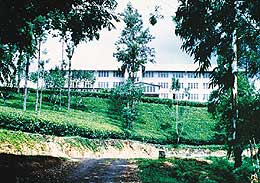 The Hapugastenne Factory produces 1.1 million kgs of tea each
year - enough to make 352,000 million cups of tea.
The Hapugastenne Factory produces 1.1 million kgs of tea each
year - enough to make 352,000 million cups of tea.
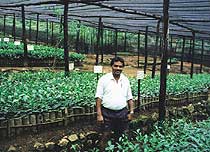 New, healthy clonal tea plants are now being planted to improve
tea quality and production.
New, healthy clonal tea plants are now being planted to improve
tea quality and production.
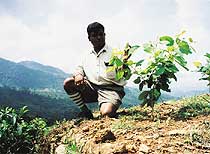 Replanting fuel wood - a two month old eucalyptus torreliana
Replanting fuel wood - a two month old eucalyptus torreliana
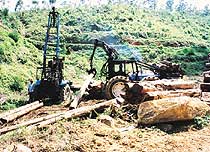 Over mature eucalyptus trees felled for electricity poles and
railway sleepers. The slopes in the background are being replanted.
Over mature eucalyptus trees felled for electricity poles and
railway sleepers. The slopes in the background are being replanted.
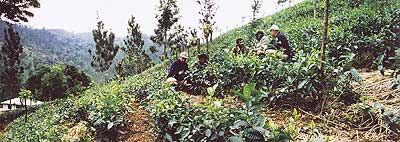 One year old tea plants. The straw (thatching material) helps
retain moisture, reduces weed growth and prevents soil erosion. Tea
fields are often quite steeply sloping.
One year old tea plants. The straw (thatching material) helps
retain moisture, reduces weed growth and prevents soil erosion. Tea
fields are often quite steeply sloping.